
Question Number 209314 by SonGoku last updated on 06/Jul/24
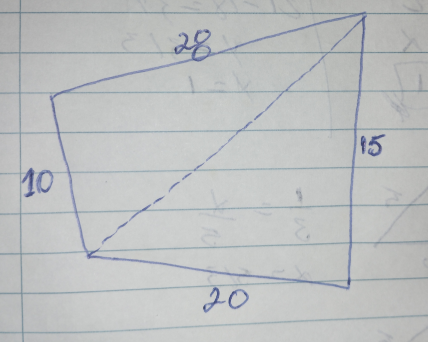
Commented by SonGoku last updated on 06/Jul/24

$$\mathrm{How}\:\mathrm{to}\:\mathrm{find}\:\mathrm{the}\:\mathrm{of}\:\mathrm{this}\:\mathrm{polygon}? \\ $$
Commented by mr W last updated on 07/Jul/24

$${you}\:{can}\:{only}\:{find}\:{the}\:{perimeter}\:{of} \\ $$$${the}\:{polygon},\:{nothing}\:{else}\:{of}\:{it}. \\ $$
Commented by SonGoku last updated on 07/Jul/24

$$\mathrm{So}\:\mathrm{the}\:\mathrm{only}\:\mathrm{way}\:\mathrm{to}\:\mathrm{determine}\:\mathrm{the}\:\mathrm{diagonal}\:\mathrm{of}\:\mathrm{ang} \\ $$$$\mathrm{irreular}\:\mathrm{polygon},\:\mathrm{like}\:\mathrm{the}\:\mathrm{one}\:\mathrm{in}\:\mathrm{the}\:\mathrm{image},\:\mathrm{is}\:\mathrm{onlyo} \\ $$$$\mathrm{thrugh}\:\mathrm{practice}?\:\mathrm{In}\:\mathrm{other}\:\mathrm{words},\:\mathrm{in}\:\mathrm{the}\:\mathrm{field}? \\ $$
Commented by Frix last updated on 07/Jul/24
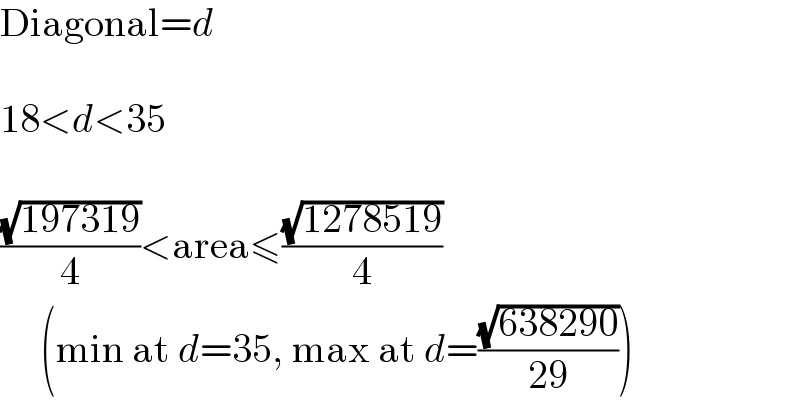
$$\mathrm{Diagonal}={d} \\ $$$$ \\ $$$$\mathrm{18}<{d}<\mathrm{35} \\ $$$$ \\ $$$$\frac{\sqrt{\mathrm{197319}}}{\mathrm{4}}<\mathrm{area}\leqslant\frac{\sqrt{\mathrm{1278519}}}{\mathrm{4}} \\ $$$$\:\:\:\:\:\left(\mathrm{min}\:\mathrm{at}\:{d}=\mathrm{35},\:\mathrm{max}\:\mathrm{at}\:{d}=\frac{\sqrt{\mathrm{638290}}}{\mathrm{29}}\right) \\ $$
Commented by Frix last updated on 07/Jul/24

$$\mathrm{For}\:\mathrm{1}\:\mathrm{triangle}\:\mathrm{you}\:\mathrm{need}\:\mathrm{at}\:\mathrm{least}\:\mathrm{3}\:\mathrm{measurements}. \\ $$$$\mathrm{In}\:\mathrm{this}\:\mathrm{case},\:\mathrm{you}\:\mathrm{need}\:\mathrm{1}\:\mathrm{additional}\:\mathrm{measurment} \\ $$$$\mathrm{for}\:\mathrm{one}\:\mathrm{of}\:\mathrm{the}\:\mathrm{triangles},\:\mathrm{the}\:\mathrm{rest}\:\mathrm{follows}. \\ $$
Commented by SonGoku last updated on 08/Jul/24

$$\mathrm{But},\:\mathrm{how}\:\mathrm{did}\:\mathrm{you}\:\mathrm{at}\:\mathrm{these}\:\mathrm{calculations}? \\ $$
Commented by Frix last updated on 08/Jul/24
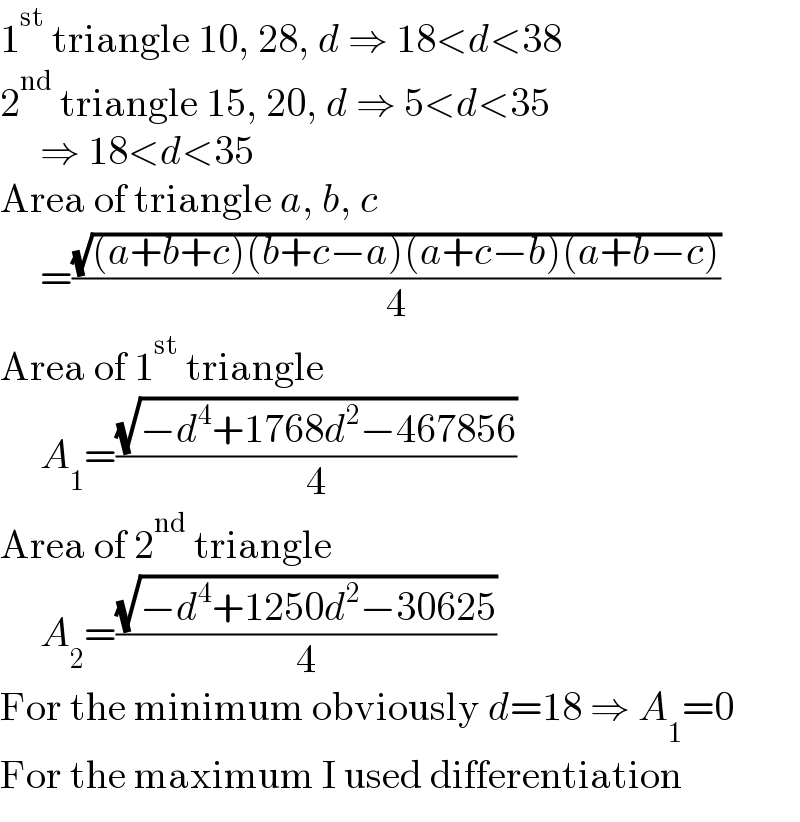
$$\mathrm{1}^{\mathrm{st}} \:\mathrm{triangle}\:\mathrm{10},\:\mathrm{28},\:{d}\:\Rightarrow\:\mathrm{18}<{d}<\mathrm{38} \\ $$$$\mathrm{2}^{\mathrm{nd}} \:\mathrm{triangle}\:\mathrm{15},\:\mathrm{20},\:{d}\:\Rightarrow\:\mathrm{5}<{d}<\mathrm{35} \\ $$$$\:\:\:\:\:\Rightarrow\:\mathrm{18}<{d}<\mathrm{35} \\ $$$$\mathrm{Area}\:\mathrm{of}\:\mathrm{triangle}\:{a},\:{b},\:{c} \\ $$$$\:\:\:\:\:=\frac{\sqrt{\left({a}+{b}+{c}\right)\left({b}+{c}−{a}\right)\left({a}+{c}−{b}\right)\left({a}+{b}−{c}\right)}}{\mathrm{4}} \\ $$$$\mathrm{Area}\:\mathrm{of}\:\mathrm{1}^{\mathrm{st}} \:\mathrm{triangle} \\ $$$$\:\:\:\:\:{A}_{\mathrm{1}} =\frac{\sqrt{−{d}^{\mathrm{4}} +\mathrm{1768}{d}^{\mathrm{2}} −\mathrm{467856}}}{\mathrm{4}} \\ $$$$\mathrm{Area}\:\mathrm{of}\:\mathrm{2}^{\mathrm{nd}} \:\mathrm{triangle} \\ $$$$\:\:\:\:\:{A}_{\mathrm{2}} =\frac{\sqrt{−{d}^{\mathrm{4}} +\mathrm{1250}{d}^{\mathrm{2}} −\mathrm{30625}}}{\mathrm{4}} \\ $$$$\mathrm{For}\:\mathrm{the}\:\mathrm{minimum}\:\mathrm{obviously}\:{d}=\mathrm{18}\:\Rightarrow\:{A}_{\mathrm{1}} =\mathrm{0} \\ $$$$\mathrm{For}\:\mathrm{the}\:\mathrm{maximum}\:\mathrm{I}\:\mathrm{used}\:\mathrm{differentiation} \\ $$
Commented by mr W last updated on 08/Jul/24
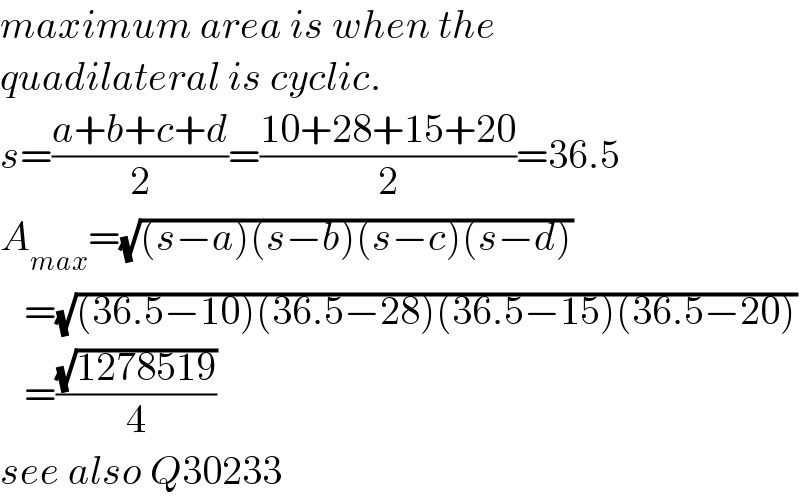
$${maximum}\:{area}\:{is}\:{when}\:{the} \\ $$$${quadilateral}\:{is}\:{cyclic}. \\ $$$${s}=\frac{{a}+{b}+{c}+{d}}{\mathrm{2}}=\frac{\mathrm{10}+\mathrm{28}+\mathrm{15}+\mathrm{20}}{\mathrm{2}}=\mathrm{36}.\mathrm{5} \\ $$$${A}_{{max}} =\sqrt{\left({s}−{a}\right)\left({s}−{b}\right)\left({s}−{c}\right)\left({s}−{d}\right)} \\ $$$$\:\:\:=\sqrt{\left(\mathrm{36}.\mathrm{5}−\mathrm{10}\right)\left(\mathrm{36}.\mathrm{5}−\mathrm{28}\right)\left(\mathrm{36}.\mathrm{5}−\mathrm{15}\right)\left(\mathrm{36}.\mathrm{5}−\mathrm{20}\right)} \\ $$$$\:\:\:=\frac{\sqrt{\mathrm{1278519}}}{\mathrm{4}} \\ $$$${see}\:{also}\:{Q}\mathrm{30233} \\ $$
Commented by SonGoku last updated on 09/Jul/24

$$\mathrm{Very}\:\mathrm{sophisticated}.\: \\ $$$$\mathrm{Congratulations} \\ $$$$\mathrm{I}\:\mathrm{willa}\:\mathrm{study}. \\ $$$$\mathrm{Thank}\:\mathrm{you}. \\ $$
Commented by SonGoku last updated on 09/Jul/24

$$\mathrm{So},\:\mathrm{can}\:\mathrm{I}\:\mathrm{use}\:\mathrm{this}\:\mathrm{formula}\:\mathrm{to}\:\mathrm{determine}\:\mathrm{the}\:\mathrm{area}\:\mathrm{of} \\ $$$$\mathrm{any}\:\mathrm{quadrilateral}? \\ $$
Commented by mr W last updated on 09/Jul/24
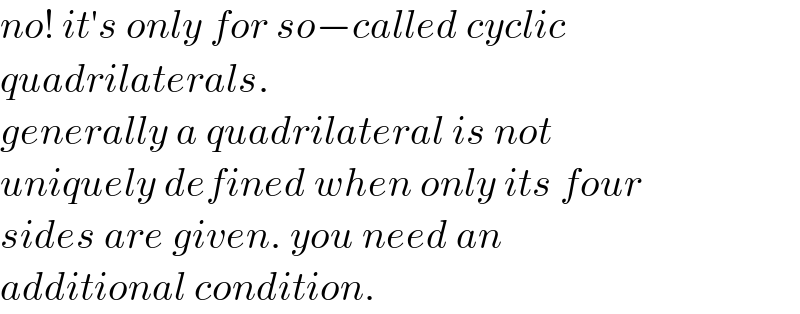
$${no}!\:{it}'{s}\:{only}\:{for}\:{so}−{called}\:{cyclic} \\ $$$${quadrilaterals}. \\ $$$${generally}\:{a}\:{quadrilateral}\:{is}\:{not} \\ $$$${uniquely}\:{defined}\:{when}\:{only}\:{its}\:{four} \\ $$$${sides}\:{are}\:{given}.\:{you}\:{need}\:{an} \\ $$$${additional}\:{condition}. \\ $$
